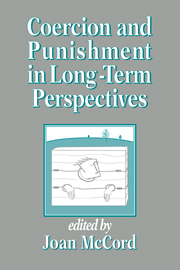Book contents
- Frontmatter
- Contents
- List of contributors
- Acknowledgments
- 1 Introduction: coercion and punishment in the fabric of social relations
- I Mental health, coercion, and punishment
- II Family socialization practices and antisocial behavior
- III Aggression and coercion in the schools
- IV Deviance, crime, and discipline
- V Measuring and predicting in studies of coercion and punishment
- 19 Corporal punishment in everyday life: an intergenerational perspective
- 20 Coercive family process and delinquency: some methodological considerations
- 21 Sex roles as coercion
- Name index
- Subject index
21 - Sex roles as coercion
Published online by Cambridge University Press: 29 September 2009
- Frontmatter
- Contents
- List of contributors
- Acknowledgments
- 1 Introduction: coercion and punishment in the fabric of social relations
- I Mental health, coercion, and punishment
- II Family socialization practices and antisocial behavior
- III Aggression and coercion in the schools
- IV Deviance, crime, and discipline
- V Measuring and predicting in studies of coercion and punishment
- 19 Corporal punishment in everyday life: an intergenerational perspective
- 20 Coercive family process and delinquency: some methodological considerations
- 21 Sex roles as coercion
- Name index
- Subject index
Summary
Sex roles are a coercive aspect of socialization to the extent that conditions of restraint or domination define them, and explicit or implicit threat or force molds their assimilation. Inequities in opportunity by virtue of gender identity alone qualify as instances of restraint; and sex role assimilation in a climate of threat or force is coercive by definition. In this chapter, normative sex role development is examined as a source of coercion, and psychiatric disturbance is examined as the effect of excessive coercion modulated by sex role expectations. We treat childhood aggression and withdrawal first as dimensions of social interaction that are implicated in normative sex role socialization. In this context, we examine childhood peer relations, parental approval, and later personality functioning. We then treat aggression and withdrawal as psychiatric risk factors that signal extremes of coercive sex role socialization, as well as examine sex differences in later psychiatric disorders from this perspective.
Peer aggression and withdrawal
Sex differences in children's peer-directed aggression and social withdrawal vary as a function of the form and context of the behavior (Frodi, Macaulay, & Thome, 1977; Huston, 1983). Physical and instrumental forms of aggression are more frequently observed among boys than girls (Bjorkquist, Lagerspetz, & Kaukiainen, 1992; Serbin, Marchessault, Peters, McAffer, & Schwartzman, 1993), and the openly fearful, avoidant behaviors are more frequently observed among girls than boys (Maccoby & Jacklin, 1974).
- Type
- Chapter
- Information
- Coercion and Punishment in Long-Term Perspectives , pp. 362 - 376Publisher: Cambridge University PressPrint publication year: 1995
- 7
- Cited by

